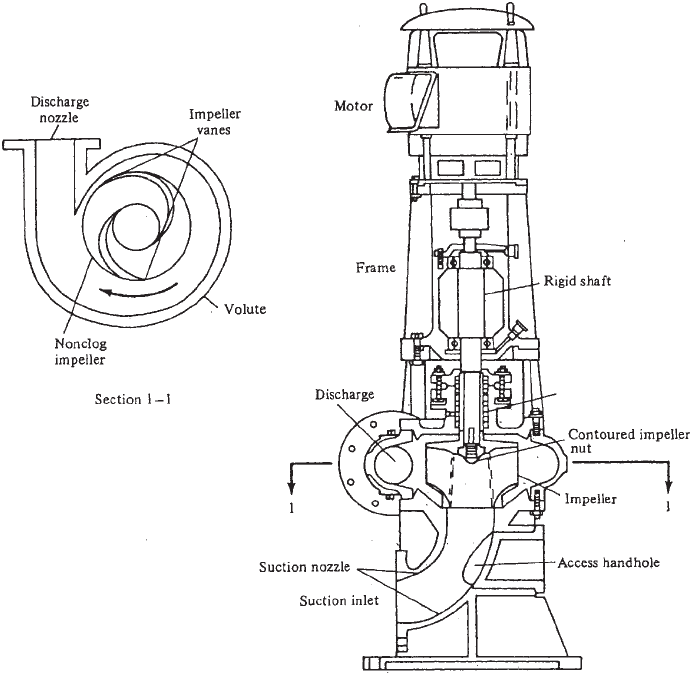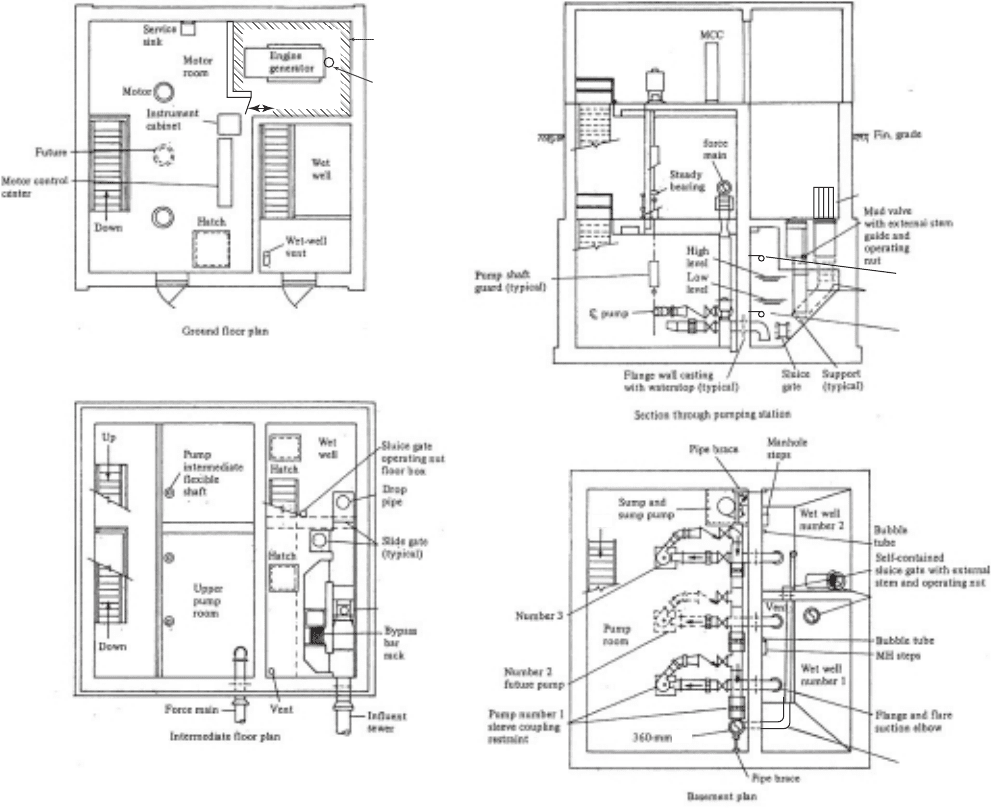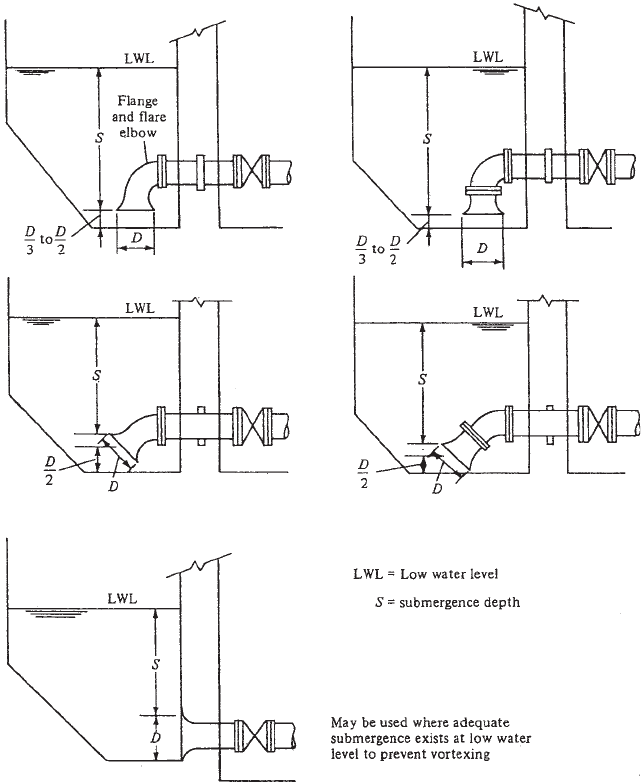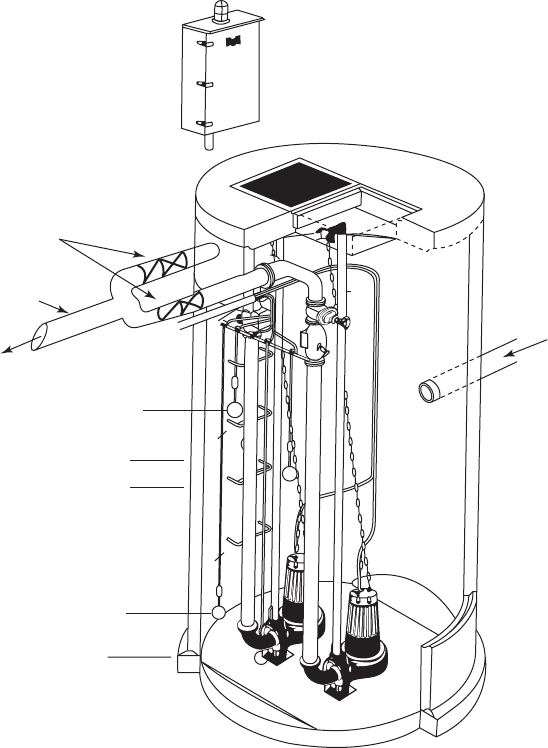Water and Wastewater Engineering
Подождите немного. Документ загружается.


19-30 WATER AND WASTEWATER ENGINEERING
wastewater in the main flows to the lowest local elevation by gravity. When the next upstream
valve opens, the new slug pus hes the downstream slug further downstream. After a number of
these sequential valve openings, the wastewater arrives at a central vacuum source and a transfer
device, such as a pump, moves
the wastewater to a treatment plant or an interceptor sewer.
The advantages of the vacuum system are similar to those for the pressu re system. In addi-
tion, higher dissolved oxygen in the wastewater, central power usage at the vacuum station, and
reduced concern for exfiltration of waste are beneficial.
The disadvantages include higher energy and operating cost
s, the need for exact grade align-
ment, greater infiltration potential, and less tolerance to flows exceeding the design flow. In addi-
tion, vacuum systems are limited in their capability to lift sewage.
Comparison with Conventional Sewers. Table 19-6 summarizes the relative characteristics
of alternative and conventional sewers.
General Design Considerations
Small-Diameter Gravity Sewers. The preliminary considerations in the design of SDG sewers
are the same as those for a conventional gravity sewer, that is, mapping, flow rate estimation,
and so on. SDG sewers have a minimum recommended diameter of 50 mm. Pressure-rated pipe
materials such as PVC are recommended. Manning’s eq
uation is used for the design.
An item of concern in the design is to ensure that the maximum hydraulic gradient does not
cause backflow into an individual or group of septic tanks. Backflow prevention valves may be
required. Pump discharge lines should have c heck valve
s to prevent drawback backwater entry
from the sewer. Manholes should be avoided because they result in additional water, grit, and
other debris.
Pressure Pipe. Flow design values are commonly based on the number of houses being served.
WEF (1986) provides graphical estimating guides bas
ed on research conducted in the 1970s and
1980s. Pipe materials will be subject to a constant variation in working pressures. Therefore, the
TABLE 19-6
Relative characteristics of alternative sewers
Sewer type
Ideal
topography
Construction
cost in rocky,
high ground
water sites
Sulfide
potential
Minimum
slope or
velocity
required
O/M
requirements
Ideal power
requirements
SDG Downhill Moderate High No Low-mod. None
STEP Uphill Low High No Mod.-high Low
GP Uphill Low Mod.-high Yes Mod.-high Moderate
VacuumFlat Low Low Yes High High
Conventional Downhill High Moderate Yes Mo
derate None
SDG—STEP Undulating Low-mod. High No Moderate Low
Conv.—GP Undulating Mod.-high Moderate Yes Mod.-high Low-mod.
Conv.—Vac.Undulating Mod.-high Low-mod.Yes High Mod.-high
Source: WEF, 1986.
SANITARY SEWER DESIGN 19-31
piping system should be designed based on cyclic surging. Fatigue failure must be considered in
the design. Pressure rated PVC has generally been the pipe material of choice.
In contrast to pressure water distribution systems, in GP systems the layout of the collection
system is
dendritic. STEP systems may have loops with valves to provide predicable flow direc-
tions. The looping provides alternative routing when repairs need to be made. Either Manning’s
equation or the Hazen-Williams equation is used for design. The Hazen-Williams equation is
most often used. The value of C usually varies between 140 and 160 for PVC pipe. When using
the GP syste
m, the design velocity should be greater than 0.6 m/s. A velocity of 0.3 m/s is ade-
quate for the STEP system because the septic tank removes a majority of the grit and grease.
P umping “uphill” is usu ally the preferred practice. In some cases “downhill” pumping is
unavoi
dable. When downhill situations occur, air enters the pipeline. This results in two-phase
flow and high headlosses.
Vacuum Sewers. The pipe materials used for pressure sewers are suitable for vacuum systems.
Pipe diameters are on the order of 75 to 100 mm. The difficulty in design is the fact that the flow
regime is two phase and cyc
lic. WEF (1986) provides design equations.
19-5 PUMP STATION DESIGN
W a stewater pumping stations are generally classified as one of the following types: wet well/dry
well; submersible; suction lift; and screw pump. Only the first two will be discussed here.
P ump station design includes the following elements: force main design, pump selection, and
station layo
ut. These are the topics of this section.
Force Main Design
A s noted earlier in this chapter, a force main is a pipeline designed to carry wastewater under
pressure from the pump station to one of the following discharge points: a gravity sewer, a stor-
age tank, or a wastewater treatment plant. The internal pressure of a force main is usually at a
maximum at the pumping station. It decreases to, or nearly to, atmospheri
c pressure at the point
of discharge.
The force main is an integral part of the pumping system, as its design and the system head-
capacity curve are required to size the pump(s).
Design Equation. The Hazen-Williams equation (Equation 3-5, Chapter 3) is usually used to
determine friction losses in the force main. To avoi
d pump cavitation in newly installed pipe, it
is recommended that system head-capacity curves be developed using Hazen-Williams C values
for both new pipe and design year pipe (Metcalf & Eddy, 1981). Suggested values are listed in
Table 19-7 .
Force Main Velocities. Because the flow rate of sewage is highly variable, particularl
y in
small districts where nighttime flows may be zero, the design criteria for force mains is funda-
mentally based on velocity. From observations, it has been recognized that velocities equal to or
greater than 0.6 m/s are required to prevent solids from settling out. It has also been observed that
velocities
greater than or equal to 1.1 m/s are required to resuspend deposited solids (Metcalf &
Eddy, 1981).

19-32 WATER AND WASTEWATER ENGINEERING
For a small-or medium-sized pumping station that pumps intermittently, the recommended
minimum velocity is 1.1 m /s. A des irable velocity is 1.5 m/s. In larger pum p stations where
pumping is continuous because the influent flow rate is large and
continuous, velocities on the
order of 0.7 to 1.5 m/s are recommended.
Pipe Materials. The pipe materials that are suitable for water distribution systems are also suit-
able for force mains (Chapter 17). The potential for crown corrosion, especially when pumping is
intermittent, must be considered in selecting the pipe material.
Depth of Cover. In
comparison to gravity sewers, force mains are laid at a comparatively
shallow depth. A minimum cover of 0.9 m is used to m inim ize the im pac t of live loads. In c old
climates, the depth should be sufficient to protect against freezing.
Appurtenances. Two appurtenances that are not encountered in water dis
tribution systems,
but are particular to force mains, are air and vacuum valves. A blowoff i s a controlled outlet that
permits the draining or flushing of the pipe. They may be found at long depressed sections. They
consist of a manhole and an appropriate valve.
Air valves are used at high points in the force main to allow trapped air and other ga
ses to be
released. The gas bubbles become trapped at the high points because intermittent pumping allows
the release of entrained and dissolved gases.
Pump Selection
Sewage is commonly pumped using specially designed centrifugal pu mps . Of the three
types of centrifugal pumps, axial flow pumps are not recommended for use with untreated
wastewater.
Nonclog, radial-flow pumps are designed to handle untreated was tewater. Common d
esign
features include enclosed impellers with less than four vanes for very large pumps and, usually,
less than three for smaller sizes. Because a 70 mm diameter solid can pass through most toilet
bowls (e.g., toy fire engines and baby dolls), GLUMRB (2004) specifies that pum
ps handling
untreated wastewater must be capable of passing a sphere at least 80 mm in diameter and that
pump suction and discharge openings be at least 100 mm in diameter.
Mixed-flow volute pumps may also be used to pump untreated wastewater. These pumps oper-
ate at higher speeds than radial flow, nonclog pumps. The
y are usually of lighter construction,
TABLE 19-7
Suggested Hazen-Williams C values for force main design
Pipe material Age
C
Lined DIP New 140
Design year 120
Plastic pipe New 150
Design year 120
Source: Data extracted from Metcalf & Eddy, 1981.

SANITARY SEWER DESIGN 19-33
and the size of solid that can pass a mixed-flow pump is smaller than a comparable nonclog radial
flow pump. The lighter construction often means a lower cost.
The pump shafts may be horizontal or vertical. The vertical pumps are often preferred
because of space limitations. They require less floor space, elim
inate high points in suction lines,
and permit vertical separation of the pump and motor. A typical vertical shaft, radial-flow waste-
water pump is shown in Figure 19-15 .
Conventional Pump Station Design
Conventional pump stations are required for larger flows ( 0.2 m
3
/ s) or where the wastewater
must be screened to protect the pumps. Conventional stations are custom-designed for a particular
location.
Mechanical seal
FIGURE 19-15
T ypical vertical shaft radial-flow wastewater pump. (Source: Metcalf & Eddy, 1981.)

19-34 WATER AND WASTEWATER ENGINEERING
General Features. Typical schematic views of a conventional pump station are shown in
Figure 19-16 . When located in residential neighborhoods, the building exterior should blend in
with the character of the residential build ings. However, actual window openings are normally
omitted to increase security of the building. Fal
se windows and architectural features are provided
to enhance the characteristics to blend in with the surrounding buildings.
Doors must be wide enough to remove and replace equipment. In large stations, overhead
bridge cranes are provided. Floor openings and hatches are provided for rem
oving equipment
from lower floors.
Mechanical screen
Mechanical
screen
(manual)
Soundproof
wall
Stack
vent
HWL alarm float
Recirculation
line to
flush and
break up scum
LWL alarm float
and pump shutoff
DIP
DIP drop
pipes
DIP
Up
DIP drop
pipes
FIGURE 19-16
T ypical, conventional wastewater pumping station. ( Source: Metcalf & Eddy, 1981.)

SANITARY SEWER DESIGN 19-35
The ground floor must be set above the flood plain of the surrounding area. In both the substruc-
ture and superstructure, the wet well and dry well must be isolated from each other. This isolation
must be vapor tight to ensure that volatile and poisonous gases (CH
4
and H
2
S, respectively, from
anaerobic decomposition of the sewage) cannot move from the wet well to the dry well.
Backup power is provided by a generator or secondary power with automatic switc hing. It
must be properly vented. Fuel storage must meet local fire codes. Alternatively, natural gas may
be
used as fuel.
Wet Well. The fundamental purposes of the wet well are storage of wastewater and the provi-
sion of sufficient submergence of the pump suction inlet to prevent vortexes from forming and air
entrainment that will cause pump cavitation. In addition, space is often provided in the wet well
for bar racks to protect the pumps from c
logging.
GLUMRB (2004) specifies that bar racks shall be provided for pumps handling wastewater
from sewers that are 750 mm or larger. The bar rack spacing varies from 25 to 150 mm between
bars. It is suggested that distance between bars be one-third the size of the maximum solid diam-
eter that the pump can pass
(Metcalf & Eddy, 1981). The screenings from the bar rack must either
be removed from the pumping station for disposal or be ground up and returned to the flow.
GLUMRB (2004) specifies that the effective volume of the wet well shall be based on the
design average flow and a filling time not to exceed 30 minutes. An effective way to design the
volume is to bas
e it on the method of pump operation, keeping in mind that short cycling times
between pump starts will wear out the pump and motor. When a variable speed drive (also known
as a variable frequency drive or VFD ) or a magna drive is used, the required storage volume is
small. To prevent short-cycling, constant speed pumps require a large volum
e. The suggested
time between starts is a function of the motor size (Metcalf & Eddy, 1981):
• For motors less than 15 kW: 15 minutes is recommended;
• For motors between 15 and 75 kW: 15 minutes;
• For motors between 75 and 200 kW: 20 to 30 minu
tes.
The volume of the wet well between start and stop elevations for a single pump or a single-
speed pump control step for multiple-speed operation is given by (BSCE, 1961):
Qt
4
V
(19-12)
where
required capacity m,
3
V
Q p ump capacity, m
3
/ min or increment in pumping capacity where one pump is already
operating and a second pump is started or where pump speed is increased
t minimum time in minutes of one pumping cycle (time between successive starts or
changes in speed of a pu
mp)
The derivation of this equation is provided in Metcalf & Eddy (1981). The current trend is to use
variable frequency drives (VFD) to match incoming flow. This allows for a reduction in the vol-
ume of the wet well and minimizes the peak discharge to downstream sewers or the wastewater
treatment plant.
In small pumping stations where one pump i
s designed to meet the capacity, the pump capac-
ity ( Q ) is the peak hour flow rate flowing into the wet well. If two identical pumps are provided,

19-36 WATER AND WASTEWATER ENGINEERING
one of which is a standby pump, the volume computed by Equation 19-12 can be reduced by half
by alternating the pumps.
In very large lift stations, the required wet well volume is provided using two or more com-
partments. Each section should be provided with a slide gate s
o that it can be isolated when it is
out of service for maintenance. Submersible pumps m ay be used for deep systems. They elimi-
nate long shafts, bearings, guards, and maintenance headaches.
Alternative suction bell piping arrangements are shown in Figure 19-17 . The submergence
depths are
shown in Table 19-8. Inlet velocities should be in the range of 1.2 to 1.8 m/s. Discharge
velocities range from 1.8 to 2.4 m/s.
FIGURE 19-17
P ump suction connections to wet well. Diameters ( D ) and submergence ( S ) are given in Table 16-8.
( Source: Metcalf & Eddy, 1981.)

SANITARY SEWER DESIGN 19-37
The shape of the wet well is important to minimize the deposition of solids. It is recommended
that the floor be level from a point 0.3 to 0.4 m beyond the outermost edge of the suction bell. It
should then slope up to the opposite wall at a slope of 1:1 or greater.
Ventilation requirements are specified by the Occupational Safety and Health Administration
(OSHA). These are based on maintaining fla
mmable and toxic gas levels at 50 percent of their
hazard level (29 CFR 1910.146 (c)(5)(I)). These requirements supersede the GLUMRB (2004)
guidance.
A common problem in large stations is that of obtaining sufficient wet-well volume at a
reasonable cost. If the pump start elevation is above the invert of the incoming sewer, sewer
storage is available. The storage is compu
ted based on the backwater curve in the sewer. If the
pump start elevation is below the invert of the incoming sewer, no sewer storage is available. The
disadvantage of this design is that odor control will probably be necessary.
Dry Well. The pumps are housed in the dry well. A gutter is provided along the wall between
the wet well and the dry well. Seepage, pump drainage, and floor wash d
own is c arried to the
g utter by sloping the floor 10 mm/m. The gutter drains to a sump with a sump pump discharge.
Stairs, not ladders, are provided to move between floors. In deep pump stations, pump motors
are separated from the pump by placing them on the top floors. Alternatively, submersible pumps
are
used.
A dequate clearance around the pump and motor should be provided to allow a crew to work.
The recommended spacing is 0.9 to 1.1 m from all piping and flanges (not just the pump base).
The pump discharge connection should be made on the side of the manifold (Jones, 2000). Con-
nec
ting to the underside invites plugging of valves and piping. For the same reason, check valves
should be located in a horizontal pipe—never in a vertical pipe (GLUMRB, 2004).
Ventilation in the dry well, based on the volume below grade, should be a minimum of 15 air
changes per hour if the fan operates intermittently and six air changes per hour if it operates con-
tinu
ously (GLUMRB, 2004). Additional ventilation may be required to remove heat generated
by the pump motors.
Factory-Assembled Pump Stations
Also known as prefabricated lift stations, factory-assembled pump stations ( Figure 19-6 ) are
used in collection systems with low flows and where the need to protect the pump from clogging
TABLE 19-8
Submergence depth required to prevent vortexing in pump suction connection
Velocity at diameter D
m/s
Required submergence depth, S
m
0.6 0.3
1.0 0.6
1.5 1.0
1.8 1.4
2.1 1.7
2.4 2.15
2.7 2.6
Source: Metcalf & Eddy, 1981.

19-38 WATER AND WASTEWATER ENGINEERING
with debris is minimal. Of the three types, pneumatic ejection, dry pit, and wet pit, only the latter
two will be discussed here.
Major Physical Features. The prefab stations are manufactured in components that can be
shipped by truck. All of the equipment and appurtenances are mounted and connec ted perma-
nently within the module. The dry pit prefab stations use a modified manhole as the wet pit
( Figure 19-6 ). The wet pit prefab stations ( Figure 19-18 ) use submersible pumps to avoid the
need for a dry pit.
A s with the conventional lift stations, provision must be made to prevent flooding. Frequently,
this is accomplis hed
by elevating the top above the flood level. In addition, because the lift
Influent sewer
Separate external
valves for each
pump discharge
Force main
Effluent
Highwater alarm
float switch
Pump No.2 on
Pump No.1 on
Low water shutoff
float switch
Low water level
alarm
FIGURE 19-18
Factory-assembled lift station with submersible pumps. The external valves are placed in a chamber that allows access without
entering a confined space. (Adapted form Steel and McGhee, 1979.)
SANITARY SEWER DESIGN 19-39
station is located at a low point, there is a potential for flotation when the groundwater table is
high. Anchors or increases in the mass of the slab beyond carrying the structural load may be
employed to prevent flotation.
Prefab stations are provided with a minimum of two pumps. Each pump must have sufficient
capacity to hand
le the design peak hourly flow (GLUMRB, 2004).
Dry Pit Station. The wet well that is part of this pumping station is an oversized manhole or
pipe sections with a sloped bottom. The low water level elevation is set so that no air can enter
the suction pipe by the formation of a vortex. The top of the pump volute must be below the low
water level of the wet well to avoid air binding of the pump. The effective volume of the wet well
is between the low and high wastewater levels. It is estimated using Equ
ation 19-12.
The blower is an essential safety feature. It provides ambient air. It should be sized using the
same criteria that are specified for the conventional dry pit. Ventilation for the wet well is to be
provided by portable blowers.
Wet Pit Station. This station m ay be a steel factory-assembled station, or it may consist of
factory-asse
mbled pumps and hardware installed in a conventional concrete manhole. The effec-
tive volume is between the high and low wastewater levels. It is estimated using Equation 19-12.
Hints from the Field. To extend the life and, coincidentally, make use of the pump warranty,
stations with two pumps should be designed to operate the pumps
alternately. This has the addi-
tional benefit of being able to size the wet well for half the volume because the time between
pump starts will be doubled.
In so far as it is technically possible, pump stations should be located to minimize their
impact on the community. Consideration and funding should be provide
d for landscaping, archi-
tectural conformity, noise control, and odor control. The facility must have appropriate safe-
guards for security.
19-6 OPERATION AND MAINTENANCE
The O&M of sewers consists principally of pump station service, removal or prevention of stop-
pages, cleaning, and repairs.
When the sewer is filled to capacity and wastewater backs up into manholes, it is said to be
surcharged. This cond ition is often accompanied by backups into basement
s. This may be the
result of stoppages or flows greater than the sewers were designed for. Control of excess flow is
enhanced by local ordinances that prohibit connection of sump pumps and down spouts to the
sewer as these increase inflow and the potential for surcharging the sewer as well as sanitary
sewer overflows (SSOs). As
much as 30 percent of excessive flow may result from downspouts
and sump pump connections (Peters et al., 2007). If the surcharge is excessive, sewage will flow
out of the top of the manhole causing a SSO.
In some cases, as much as 76 percent of I/I may be a result of breaks in c
onnection between
the lateral and the main. Grouting may be an alternative to excavation and replacement for repair
of the connection, but new technologies employing cast-in-place lining are more effective.
At the extremities of the collection system where flows are low or in flat terrain, sewer clean-
ing is a prudent measure to prevent SSO and/or backups into residences and buil
dings. This may
be accomplished by flushing and the use of a vacuum truck.
